Fisheries Reference Point and Stock Status of Croaker Fishery (Sciaenidae) Exploited from the Bay of Bengal, Bangladesh
Abstract
:1. Introduction
2. Materials and Methods
2.1. Catch, Effort, and CPUE Data
2.2. Surplus Production Models (SPMs)
2.3. CMSY and BSM Model
3. Results
3.1. ASPIC Package-Derived Population Parameters
3.2. CMSY- and BSM-Derived Fisheries Reference Points (BRPs)
3.3. Stock Status of Croaker Fishery
4. Discussion
4.1. Suitability of SPMs for Fisheries Management
4.2. Population Parameters of Croaker
4.3. Maximum Sustainable Yield (MSY) of Croaker
4.4. Exploitation and Stock Status of Croaker
5. Conclusions
Supplementary Materials
Author Contributions
Funding
Institutional Review Board Statement
Informed Consent Statement
Data Availability Statement
Acknowledgments
Conflicts of Interest
References
- Zafar, M.; Mustafa, G.; Amin, S.M.N.; Haque, M.A. Population dynamics of Johnius argentatus (Houttuyn) from the northeastern part of the Bay of Bengal, Bangladesh. Asian Fish. Sci. 2000, 13, 243–249. [Google Scholar]
- Sabbir, W.; Hossain, M.Y.; Rahman, M.A.; Hasan, M.R.; Khan, M.N.; Mawa, Z.; Tanjin, S.; Sarmin, M.S.; Rahman, O.; Nima, A.; et al. Growth pattern of the Hooghly croaker Panna heterolepis (Trewavas, 1977) in the Bay of Bengal (Bangladesh) in relation to eco-climatic factors. Egypt. J. Aquat. Biol. Fish. 2020, 24, 847–862. [Google Scholar] [CrossRef]
- Sabbir, W.; Rahman, M.A.; Hossain, M.Y.; Hasan, M.R.; Mawa, Z.; Rahman, O.; Tanjin, S.; Sarmin, M.S. Stock assessment of Hooghly Croaker Panna heterolepis in the Bay of Bengal (Southern Bangladesh): Implications for sustainable management. Heliyon 2021, 7, e07711. [Google Scholar] [CrossRef]
- Froese, R.; Pauly, D. Fishbase. Available online: https://fishbase.mnhn.fr/search.php (accessed on 20 August 2021).
- Fanning, L.P.; Chowdhury, S.R.; Uddin, M.S.; Al-Mamun, M.A. Marine Fisheries Survey Reports and Stock Assessment 2019; Department of Fisheries, Government of Bangladesh: Dhaka, Bangladesh, 2019.
- DoF (Department of Fisheries). Yearbook of Fisheries Statistics of Bangladesh, 2019–2020; Department of Fisheries, Ministry of Fisheries and Livestock, Government of Bangladesh: Dhaka, Bangladesh, 2020; Volume 37.
- Uddin, K.; Reza, M.; Islam, M.; Kamal, M. Influence of salt on drying performance of silver jewfish (Otolithes argentatus) in a Hohenheim type solar tunnel dryer. J. Bangladesh Agric. Univ. 2014, 12, 227–233. [Google Scholar] [CrossRef] [Green Version]
- Lin, L.; Liu, Z.; Jiang, Y.; Huang, W.; Gao, T. Current status of small yellow croaker resources in the southern Yellow Sea and the East China Sea. Chin. J. Oceanol. Limnol. 2011, 29, 547–555. [Google Scholar] [CrossRef]
- Mustafa, M.G.; Ahmed, I.; Ilyas, M. Population Dynamics of Five Important Commercial Fish Species in the Sundarbans Ecosystem of Bangladesh. J. Appl. Life Sci. Int. 2019, 22, 1–13. [Google Scholar] [CrossRef]
- Jayasankar, P. Population dynamics of big-eye croaker Pennahia macrophthalmus and blotched croaker Nibea maculata (Sciaenidae) in the trawling grounds off Rameswaram Island, east coast of India. Indian J. Mar. Sci. 1995, 24, 153–157. [Google Scholar]
- Prager, M.H. User’s Guide for ASPIC Suite, Version 7: A Stock–Production Model Incorporating Covariates and Auxiliary Programs; Prager Consulting: Portland, OR, USA, 2016. [Google Scholar]
- Froese, R.; Demirel, N.; Coro, G.; Kleisner, K.M.; Winker, H. Estimating fisheries reference points from catch and resilience. Fish Fish. 2017, 18, 506–526. [Google Scholar] [CrossRef] [Green Version]
- Barman, P.P.; Karim, E.; Khatun, M.H.; Rahman, M.F.; Alam, M.S.; Liu, Q. Application of CMSY to Estimate Biological Reference Points of Bombay Duck (Harpadon nehereus) from the Bay of Bengal, Bangladesh. Appl. Ecol. Environ. Res. 2020, 18, 8023–8034. [Google Scholar] [CrossRef]
- Schaefer, M.B. Some aspects of the dynamics of populations important to the management of the commercial marine fisheries. Bull. Math. Biol. 1991, 53, 253–279. [Google Scholar] [CrossRef]
- Fox, W.W. An Exponential Surplus-Yield Model for Optimizing Exploited Fish Populations. Trans. Am. Fish. Soc. 1970, 99, 80–88. [Google Scholar] [CrossRef]
- Rosenberg, A.A.; Fogarty, M.J.; Cooper, A.B.; Dickey-Collas, M.; Fulton, E.A.; Gutiérrez, N.L.; Hyde, K.J.W.; Kleisner, K.M.; Kristiansen, T.; Longo, C.; et al. Developing New Approaches to Global Stock Status Assessment and Fishery Production Potential of the Seas; FAO: Rome, Italy, 2014; Volume 1086. [Google Scholar]
- Palomares, M.L.D.; Froese, R.; Derrick, B.; Nöel, S.-L.; Tsui, G.; Woroniak, J.; Pauly, D. A Preliminary Global Assessment of the Status of Exploited Marine Fish and Invertebrate Populations; Sea Around Us Project: Vancouver, BC, Canada, 2018. [Google Scholar]
- Haddon, M. Modelling and Quantitative Methods in Fisheries, 2nd ed.; Chapman and Hall/CRC: New York, NY, USA; London, UK, 2011; ISBN 9781119130536. [Google Scholar]
- Martell, S.; Froese, R. A simple method for estimating MSY from catch and resilience. Fish Fish. 2013, 14, 504–514. [Google Scholar] [CrossRef]
- Barman, P.P.; Liu, Q.; Al-Mamun, M.A.; Schneider, P.; Mozumder, M.M.H. Stock Assessment of Exploited Sardine Populations from Northeastern Bay of Bengal Water, Bangladesh Using the Length-Based Bayesian Biomass (LBB) Method. J. Mar. Sci. Eng. 2021, 9, 1137. [Google Scholar] [CrossRef]
- Pauly, D. Major Trends in Small-Scale Marine Fisheries, with Emphasis on Developing Countries, and Some Implication fro Social Sciences. Marit. Stud. 2006, 4, 7–22. [Google Scholar]
- Costello, C.; Ovando, D. Status, Institutions, and Prospects for Global Capture Fisheries. Annu. Rev. Environ. Resour. 2019, 44, 177–200. [Google Scholar] [CrossRef]
- Ji, Y.; Liu, Q.; Liao, B.; Zhang, Q.; Han, Y. Estimating biological reference points for Largehead hairtail (Trichiurus lepturus) fishery in the Yellow Sea and Bohai Sea. Acta Oceanol. Sin. 2019, 38, 20–26. [Google Scholar] [CrossRef]
- Hoggarth, D.; Abeyasekera, S.; Arthur, R.; Beddington, J.R.; Burn, R.W.; Halls, A.S.; Kirkwood, G.P.; McAllister, M.; Medley, P.; Mees, C.C.; et al. Stock Assessment for Fishery Management; FAO Fisheries Technical Paper; FAO: Rome, Italy, 2006; Volume 487, ISBN 9251055033. [Google Scholar]
- Anderson, C.N.K.; Hsieh, C.H.; Sandin, S.A.; Hewitt, R.; Hollowed, A.; Beddington, J.; May, R.M.; Sugihara, G. Why fishing magnifies fluctuations in fish abundance. Nature 2008, 452, 835–839. [Google Scholar] [CrossRef] [PubMed]
- Cheung, W.W.L.; Lam, V.W.Y.; Sarmiento, J.L.; Kearney, K.; Watson, R.; Zeller, D.; Pauly, D. Large-scale redistribution of maximum fisheries catch potential in the global ocean under climate change. Glob. Chang. Biol. 2010, 16, 24–35. [Google Scholar] [CrossRef]
- Bouch, P.; Minto, C.; Reid, D.G. Comparative performance of data-poor CMSY and data-moderate SPiCT stock assessment methods when applied to data-rich, real-world stocks. ICES J. Mar. Sci. 2021, 78, 264–276. [Google Scholar] [CrossRef]
- Zhai, L.; Liang, C.; Pauly, D. Assessments of 16 Exploited Fish Stocks in Chinese Waters Using the CMSY and BSM Methods. Front. Mar. Sci. 2020, 7, 1002. [Google Scholar] [CrossRef]
- Liang, C.; Xian, W.; Liu, S.; Pauly, D. Assessments of 14 Exploited Fish and Invertebrate Stocks in Chinese Waters Using the LBB Method. Front. Mar. Sci. 2020, 7, 314. [Google Scholar] [CrossRef]
- Kalhoro, M.A.; Liu, Q.; Memon, K.H.; Waryani, B.; Soomro, S.H. Maximum sustainable yield of Greater lizardfish Saurida tumbil fishery in Pakistan using the CEDA and ASPIC packages. Acta Oceanol. Sin. 2015, 34, 68–73. [Google Scholar] [CrossRef]
- Baset, A.; Liu, Q.; Liao, B.; Waris, A.; Yanan, H.; Qingqing, Z.; Ahmad, I. Population dynamics of bearded croaker Johnius dussumieri (Cuvier, 1830) from Pakistani waters. J. Fish. 2020, 8, 777–783. [Google Scholar]
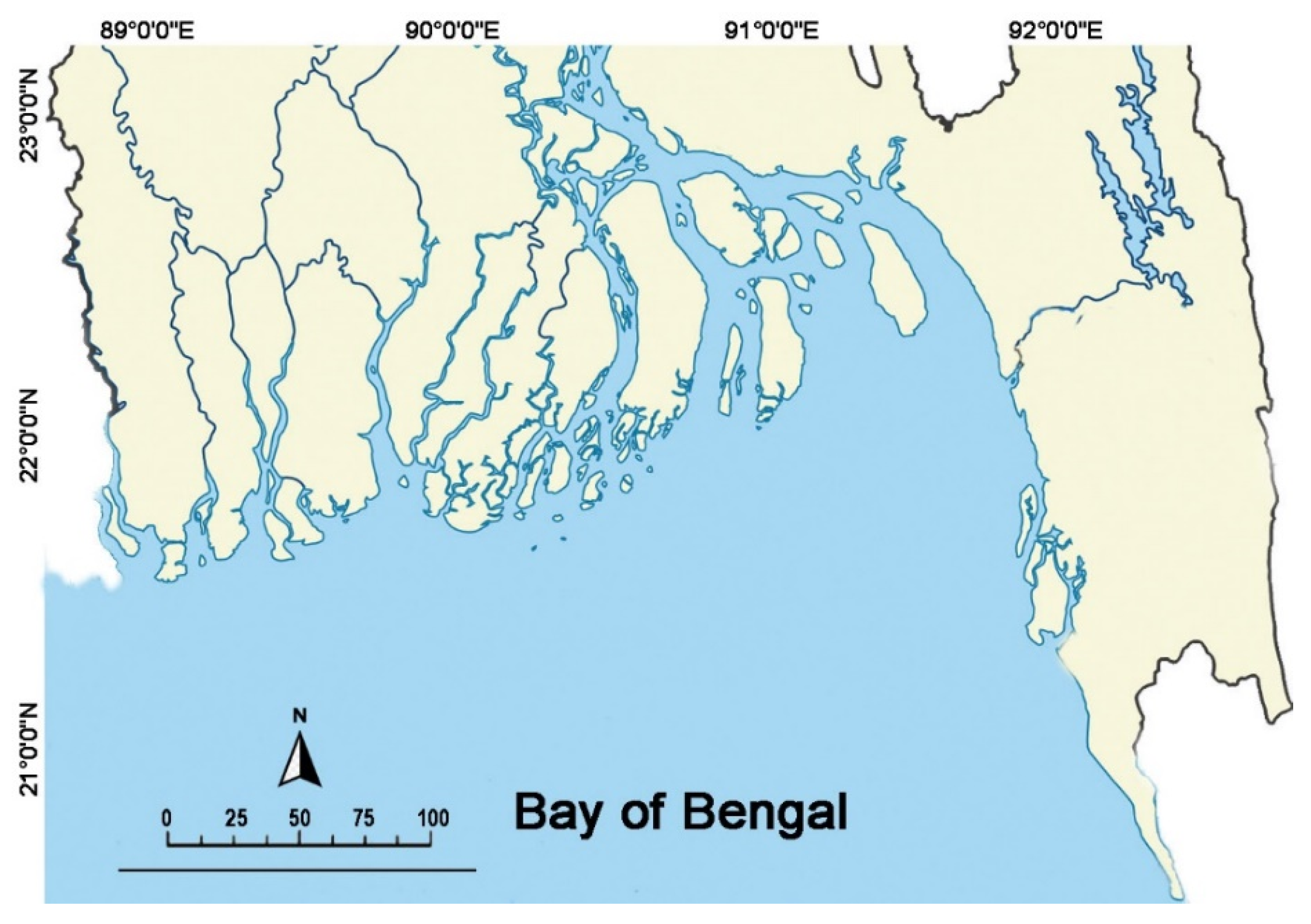
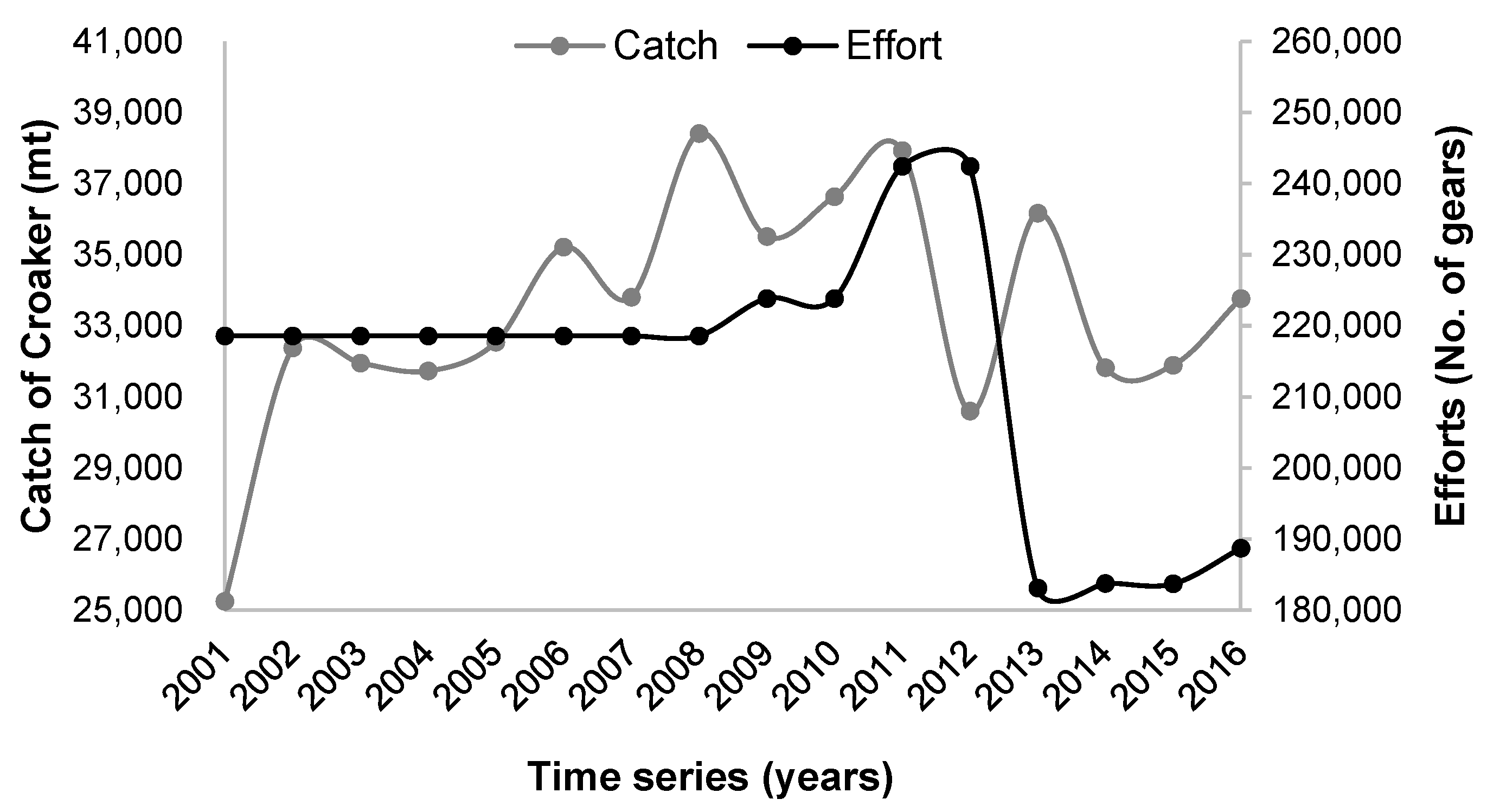
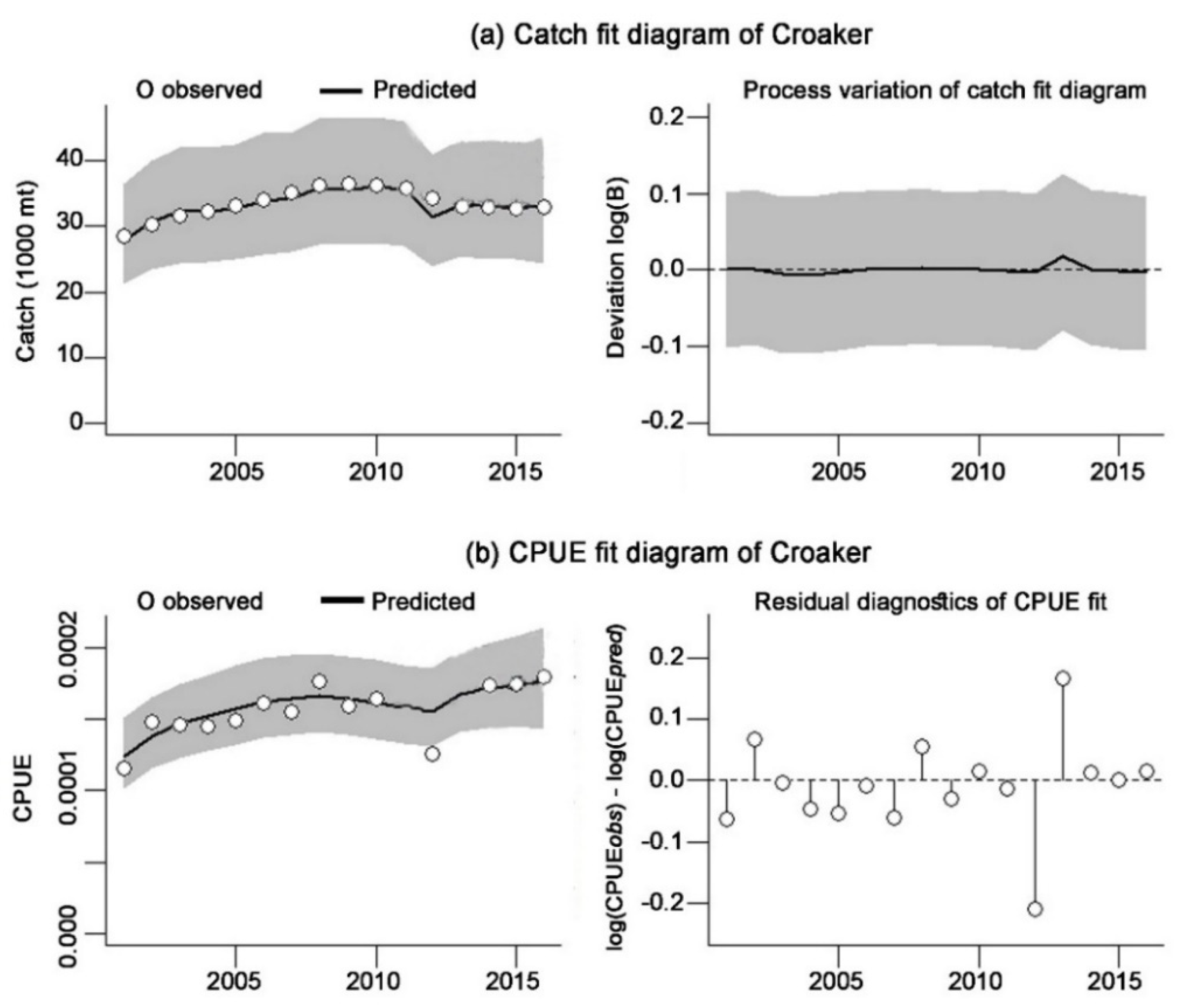
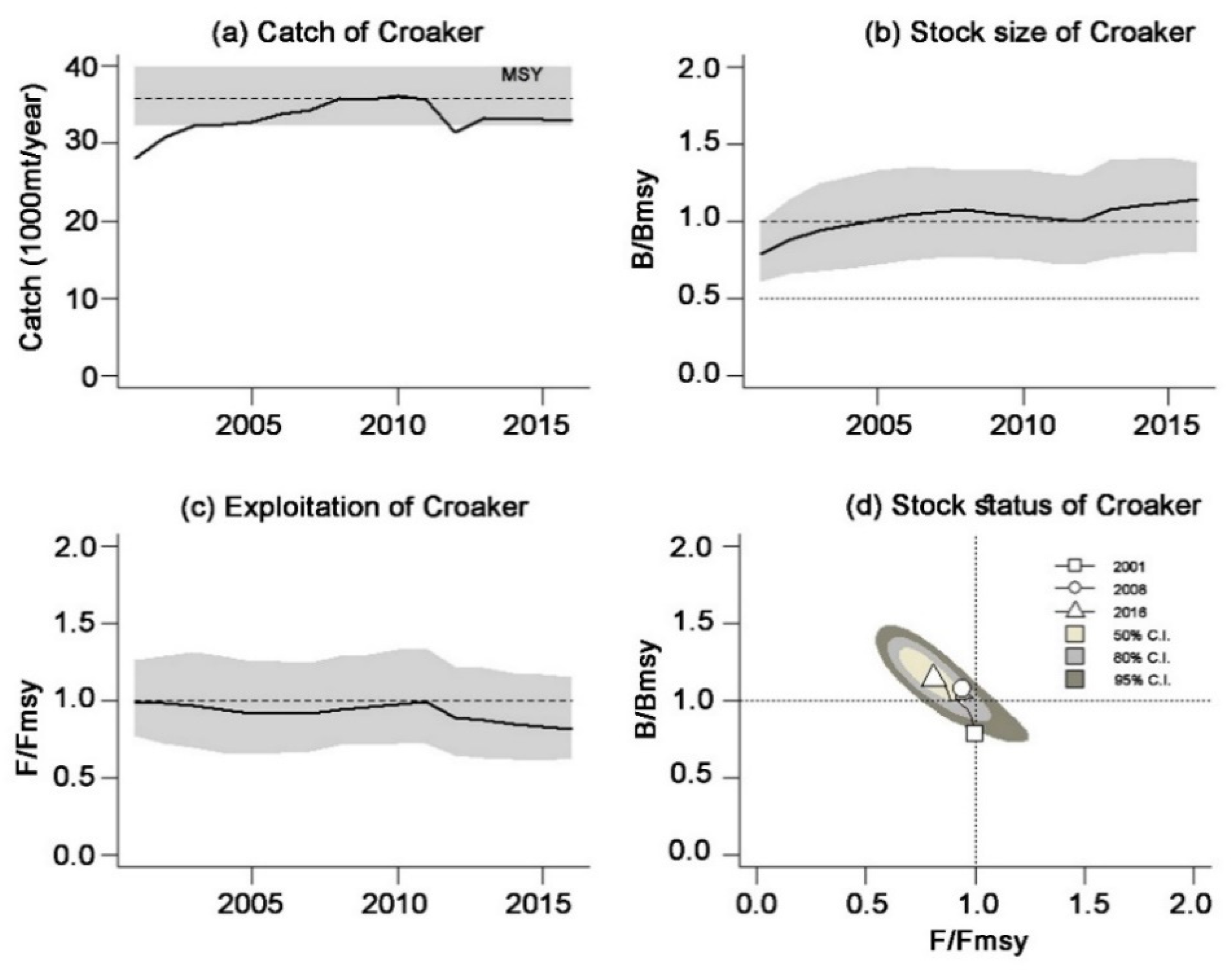
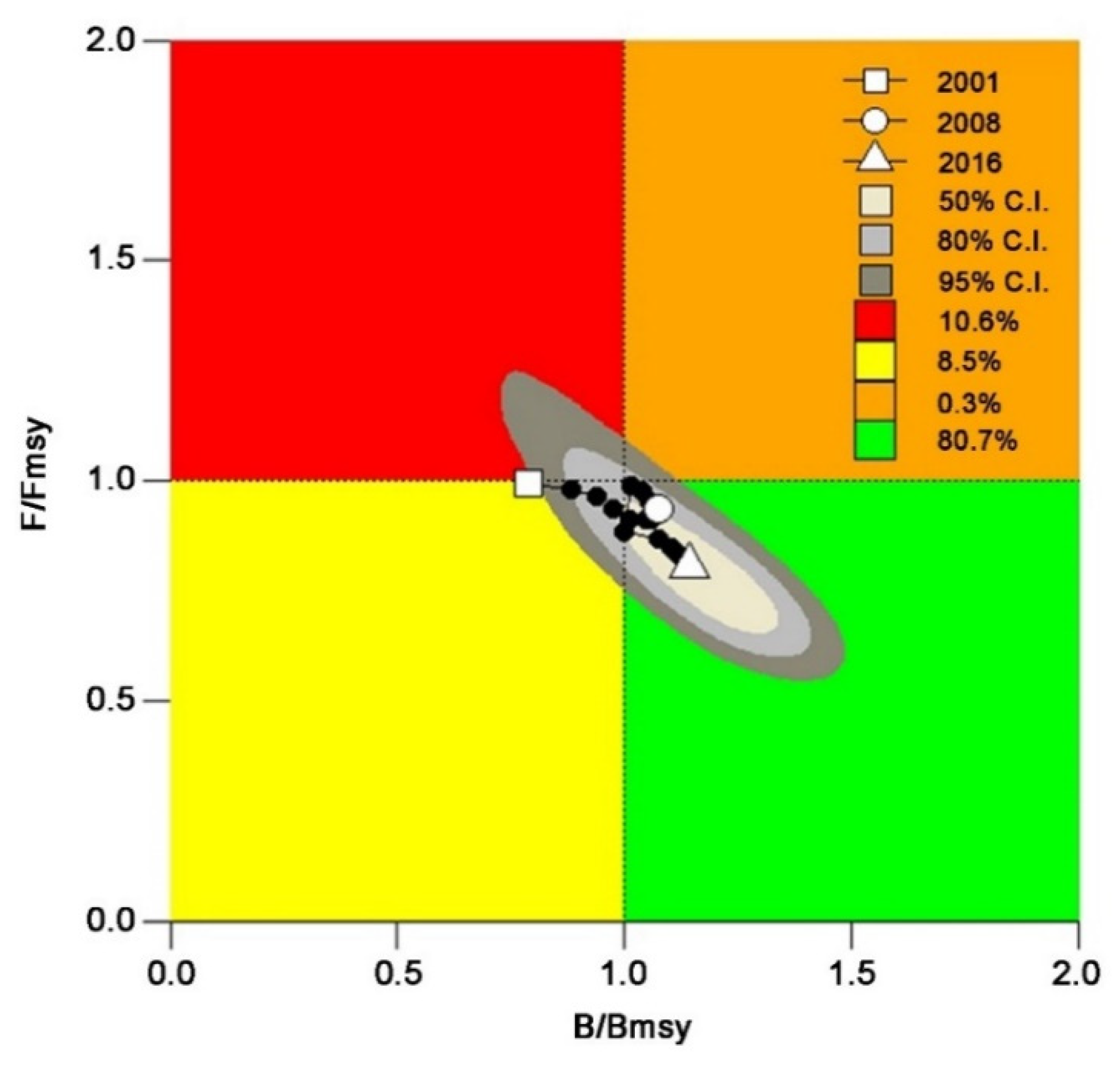
| Input Parameters | Ranges of the Values |
|---|---|
| Prior initial relative biomass | 0.2–0.6 |
| Prior intermediate relative biomass | 0.2–0.6 in year (2008) |
| Prior final relative biomass | 0.2–0.6 |
| Prior range for r | 0.6–1.5 |
| Prior range for q | 2.23 × 10−6–7.06 × 10−6 |
| Prior range for k | 69,500–208,000 |
| Year | Models | |||||||
|---|---|---|---|---|---|---|---|---|
| Fox Model | Logistic (Schaefer) Model | |||||||
| F | B | F/FMSY | B/BMSY | F | B | F/FMSY | B/BMSY | |
| 2001 | 0.358 | 7.058 × 104 | 0.94 | 0.69 | 0.374 | 6.750 × 104 | 0.92 | 0.71 |
| 2002 | 0.423 | 7.654 × 104 | 1.11 | 0.79 | 0.444 | 7.294 × 104 | 1.09 | 0.81 |
| 2003 | 0.401 | 7.970 × 104 | 1.05 | 0.82 | 0.422 | 7.577 × 104 | 1.04 | 0.84 |
| 2004 | 0.380 | 8.339 × 104 | 1.00 | 0.86 | 0.400 | 7.927 × 104 | 0.98 | 0.88 |
| 2005 | 0.374 | 8.695 × 104 | 0.99 | 0.90 | 0.393 | 8.274 × 104 | 0.97 | 0.92 |
| 2006 | 0.397 | 8.880 × 104 | 1.04 | 0.94 | 0.416 | 8.457 × 104 | 1.02 | 0.95 |
| 2007 | 0.375 | 9.018 × 104 | 0.99 | 0.94 | 0.393 | 8.594 × 104 | 0.97 | 0.96 |
| 2008 | 0.428 | 8.978 × 104 | 1.12 | 0.96 | 0.449 | 8.553 × 104 | 1.11 | 0.98 |
| 2009 | 0.400 | 8.876 × 104 | 1.06 | 0.94 | 0.420 | 8.449 × 104 | 1.03 | 0.96 |
| 2010 | 0.424 | 8.847 × 104 | 1.09 | 0.94 | 0.435 | 8.419 × 104 | 1.07 | 0.96 |
| 2011 | 0.436 | 8.695 × 104 | 1.15 | 0.93 | 0.459 | 8.263 × 104 | 1.13 | 0.95 |
| 2012 | 0.345 | 8.870 × 104 | 0.91 | 0.91 | 0.363 | 8.434 × 104 | 0.89 | 0.92 |
| 2013 | 0.397 | 9.102 × 104 | 1.05 | 0.97 | 0.417 | 8.664 × 104 | 1.03 | 0.99 |
| 2014 | 0.342 | 9.303 × 104 | 0.90 | 0.96 | 0.359 | 8.865 × 104 | 0.88 | 0.98 |
| 2015 | 0.329 | 9.706 × 104 | 0.87 | 1.00 | 0.344 | 9.262 × 104 | 0.85 | 1.01 |
| 2016 | 0.338 | 1.001 × 104 | 0.89 | 1.05 | 0.354 | 9.545 × 104 | 0.87 | 1.07 |
| Model Name | k (mt) | r (year−1) | MSY (mt) |
|---|---|---|---|
| CMSY | 127,000 (87,800–171,000) | 1.13 (0.779–1.6) | 35,900 (28,500–42,900) |
| BSM | 123,000 (90,200–178,000) | 1.12 (0.81–1.58) | 33,900 (32,300–39,800) |
| Population Parameters | Parameter Values | 95% Confident Intervals (CI) |
|---|---|---|
| MSY | 33,900 | 32,300–39,800 |
| FMSY | 0.57 | 0.41–0.79 |
| BMSY | 63,300 | 45,100–88,900 |
| Biomass (B2016) | 72,300 | 50,900–87,500 |
| B/BMSY | 1.14 | 0.80–1.38 |
| Fishing mortality (F2016) | 0.46 | 0.38–0.65 |
| Exploitation (F/FMSY) | 0.81 | 0.63–1.16 |
Publisher’s Note: MDPI stays neutral with regard to jurisdictional claims in published maps and institutional affiliations. |
© 2022 by the authors. Licensee MDPI, Basel, Switzerland. This article is an open access article distributed under the terms and conditions of the Creative Commons Attribution (CC BY) license (https://creativecommons.org/licenses/by/4.0/).
Share and Cite
Barman, P.P.; Shamsuzzaman, M.M.; Schneider, P.; Mozumder, M.M.H.; Liu, Q. Fisheries Reference Point and Stock Status of Croaker Fishery (Sciaenidae) Exploited from the Bay of Bengal, Bangladesh. J. Mar. Sci. Eng. 2022, 10, 63. https://doi.org/10.3390/jmse10010063
Barman PP, Shamsuzzaman MM, Schneider P, Mozumder MMH, Liu Q. Fisheries Reference Point and Stock Status of Croaker Fishery (Sciaenidae) Exploited from the Bay of Bengal, Bangladesh. Journal of Marine Science and Engineering. 2022; 10(1):63. https://doi.org/10.3390/jmse10010063
Chicago/Turabian StyleBarman, Partho Protim, Md. Mostafa Shamsuzzaman, Petra Schneider, Mohammad Mojibul Hoque Mozumder, and Qun Liu. 2022. "Fisheries Reference Point and Stock Status of Croaker Fishery (Sciaenidae) Exploited from the Bay of Bengal, Bangladesh" Journal of Marine Science and Engineering 10, no. 1: 63. https://doi.org/10.3390/jmse10010063
APA StyleBarman, P. P., Shamsuzzaman, M. M., Schneider, P., Mozumder, M. M. H., & Liu, Q. (2022). Fisheries Reference Point and Stock Status of Croaker Fishery (Sciaenidae) Exploited from the Bay of Bengal, Bangladesh. Journal of Marine Science and Engineering, 10(1), 63. https://doi.org/10.3390/jmse10010063









